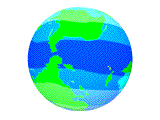
| |
 |
![]()
The West Coast of the US in general will suffer an onslaught of changes during the Pole Shift, and those living there need to consider not only each and every onslaught, but the combined effect. First, because the Pacific will shorten and subducting plates will be forced under the coastal plate suddenly and forcefully, heating of the superstrata will occur to an astonishing degree. The rock will actually melt in low lying places. Thus, valleys over subducting plates are out. Then the tidal waves will assault and where the coastline does not offer an outlet for the water, it will climb up as it has nowhere else to go. Thus, hills and mountain ranges close to the coast are out. Then there are the high winds, or hurricane force, which will occur world wide. So a safe spot must include being out of the valleys but also out of the wind. Then due to the earthquakes, which will be severe on the significant fault lines that crisscross the West Coast of the US, mountain building will occur which can result in the collapse of caves, even in granite, and renting apart of rock. Yosemite stands as an example of what can happen. And lastly, forest fires caused by exploding volcanoes, sparks, and lightning storms or perhaps the firestorms that can occur anywhere during the shift, will eliminate the forests as a shelter.
ZetaTalk ™
After the pole shift, the West Coast volcanoes will find the prevailing westerlies blowing ash out over the Pacific, not directly along the West Coast. In the new geography maps, Alaska will be on the Equator, with N America tilted upward toward the new N Pole at the Bulge of Brazil. The new Trade Winds will push some of this ash back against what had been the West Coast of N America, but the prevailing wind direction will be out over the Pacific. However the Nevada area will not be downwind from West Coast volcanoes in the Aftertime. Those close to and just downwind from these active West Coast volcanoes will of course find themselves loaded with ash, and should take all precautions. Volcanic activity is expected to be active, and creating a lot of ash, for some 25 years on average after the pole shift. However, this will be a diminishing issue, with the skies gradually clearing during this 25 year period.
ZetaTalk ™ 2010

Note Aftertime Hurricanes commentary.
Note San Andreas Slide commentary.
Note Hot Springs commentary.